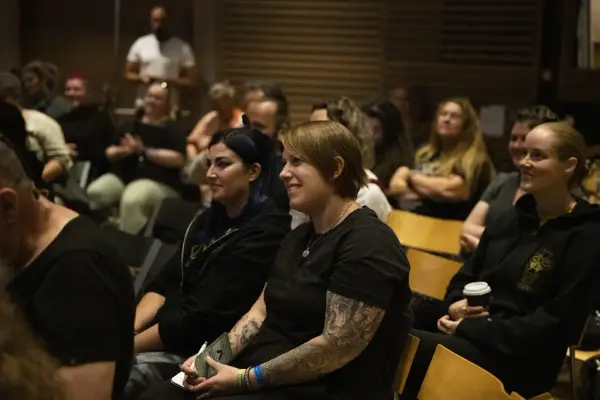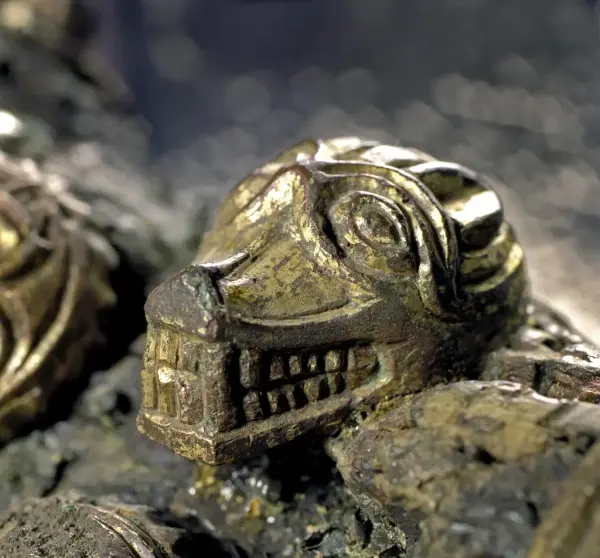Finally, Midgardsblot is back, and people from all over the world flock to Borre and its unique historical environment!
This year's festival runs from Wednesday 13th of August to Saturday 16th of August. There will be concerts, happenings, workshops, good food and drink and a Viking market.
The seminar Midgard Talks takes place every day with lectures and panels relating to Viking history, culture and music. The festival collaborates with the Midgard Viking Centre.
We set up extra activities on the playground for children and extra guided tours during the festival.
Wednesday August 13th
- 11.00 Allison Fox –– Curator, archaeology, Manx National Heritage. “Ships, mounds and holes in the ground - various ways to bury a Viking in the Isle of Man”
- 12.00 Lars Bill – Chair – Oseberg Viking Heritage Foundation. “Follow the Vikings - as far as we can!”
- 13.00 Samuel Høiland - Conservator, Tingvatn fornminnepark, Vest-Agder-Museet IKS. «The Immortals - The Vikings before the Vikings. The Migration Period in Agder and in Norway”
- 14.00 Anne Irene Risøy - Professor, University of Southeast Norway. “The Kings of Stadt” (preliminary title)
- 15.00 Charlotte Wenke - PhD Interdisciplinary Centre for Baltic Sea Region Research, University of Greifswald, Germany. “Viking Gold. Treasure Politics since 1800”
About the Wednesday speakers
Allison Fox
Title: Ships, mounds and holes in the ground - various ways to bury a Viking in the Isle of Man
Allison has a Bachelor of Science degree in Archaeological Sciences and a Master of Arts degree in Museum Studies. She is an associate member of both the Chartered Institute for Archaeologists and the Museum Association. Her role as curator involves helping to care for and explain the rich archaeological heritage of the Isle of Man, of which the Viking Age is a major part. Curator: Archaeology, Manx National Heritage, Isle of Man
Summary
At the heart of the British Isles, the Isle of Man was a vital trading post for the Vikings and by the late 800s, they had chosen to settle on the Island. After death, some were laid to rest according to the traditions of the Viking homelands, and some were buried amongst their Christian contemporaries. This talk will explore the wide range of Viking Age burial practices on the Island, highlighting two burials in particular – that of a male Viking trader buried in his ship and also a pagan female laid to rest inside a Christian cemetery – and consider whether they became part of the Manx community.
Lars Bill
Title: Follow the Vikings - as far as we can!
Lars has been an active volunteer in the Oseberg Viking heritage Foundation for the last 15 years.
Currently Lars holds the position as Head of Board in the foundation in addition to the role as
project manager for the epic voyage of the Viking ship Saga Farmann.
Summary:
Saga Farmann, an archeological reconstruction of the Knarr "Klåstadskipet" is sailing in the wake of the Vikings for the third consecutive year.
An epic voyage that started in 2023 with the goal to revisit sites and cities where the Vikings once lived, traded or worked.
So far, Saga Farmann has travelled through Europe from Norway to Istanbul and further on to the harbour of Rome in Italy.
This year the ship heads for London where the welcome will be slightly different from when the vikings battled the anglo-saxons in 1014 AD.
Modern vikings experience modern obstacles when sailing around in Europe, but also tasks and issues well known to the original vikings, we believe.
Follow the ship: www.sagafarmann.com
Samuel Høiland
Title: The Immortals - The Vikings before the Vikings. The Migration Period in Agder and in Norway
Samuel Høiland works as a project manager for “Future for the Past” at Vest-Agder Museum. His work is focused on the Migration Period in Agder and disseminate it to the public on different arenas. He holds a degree in History from the University of Agder (2018).
Summary
In 1933, four farmers made a remarkable discovery while ploughing a field at the farm Snartemo in Agder, southern Norway. They had discovered a princely tomb of a chieftain from the last decades of the Migration Period (375-550 CE). Most famous is the gold-grip sword – The Snartemo Sword. Ten km from Snartemo, at Tingvatn, a new exhibition about this rich period has opened. The western parts of Agder, Lister, is especially rich with finds from the period. Learn about this forgotten golden age, over two centuries before the Vikings sailed the seas.
Anne Irene Risøy
Title: The Kings of Stadt
Charlotte Wenke
Title: Viking Gold. Treasure Politics since 1800.
Wenke is a PhD researcher at the University of Greifswald (Gremany). After studying Art History and Scandinavian Studies, she is now investigating gold treasure finds from the Scandinavian Viking Age and their modern perceptionas objects of identity in museums of the Baltic Sea Region. Together with her team, she curated the digital exhibition "Viking Gold. Treasure Politics since 1800". Apart from her research she is involved in a metal radio program and loves coming to Midgardsblot.

